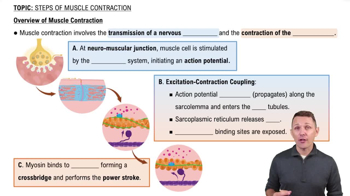Mark the following statements as true or false. If a statement is false, correct it to make a true statement.
A muscle fiber changes length during isotonic concentric and isotonic eccentric contractions.
 Verified step by step guidance
Verified step by step guidance Verified video answer for a similar problem:
Verified video answer for a similar problem:



 4:53m
4:53mMaster Overview of Muscle Contraction with a bite sized video explanation from Bruce Bryan
Start learning